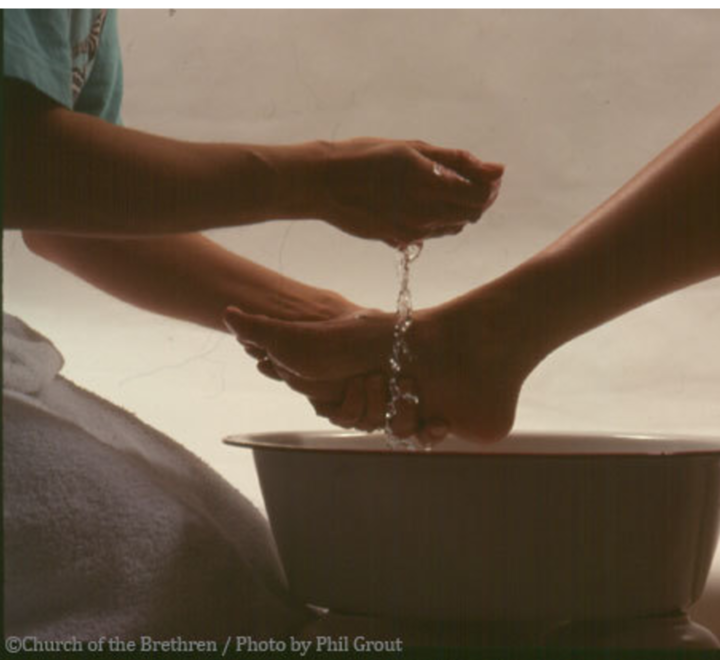Brethren ordinances are New Testament practices ordained by Jesus and practiced
by the disciples. They visibly portray our faith in Jesus Christ and his grace.
They represent what it means to be the body of Christ together.
Brethren Ordinances
Brethren Ordinances
Brethren ordinances are New Testament practices ordained by Jesus and practiced
by the disciples. They visibly portray our faith in Jesus Christ and his grace.
They represent what it means to be the body of Christ together.
Baptism
Early Brethren were concerned with restoring to the Christian church the true baptism of the New Testament. For them, that meant baptism must be for believers, not infants, and must be by triune immersion in the name of the Father, the Son, and the Holy Spirit. The New Testament teaches that baptism involves human response as well as divine initiative. Thus, for Brethren, New Testament baptism requires the voluntary, intentional action of the person being baptized. Brethren continued the “true” baptism despite formidable adversaries during the first two centuries of Brethren history.According to Alexander Mack, baptism is the believer’s act of becoming obedient to biblical command. Baptism is human response to God’s saving Action. It witnesses to the work of the Spirit and testifies to forgiveness and spiritual cleansing. The apostle Paul declared that baptism requires commitment to community. Baptism means being ordained and empowered by the Spirit to live as a member of the body that carries God’s mission to the world.
Annointing
Anointing with oil in the name of the Lord recognizes the grace and healing blessings of God. Brethren readily identified with Jesus’ healing ministry and the early church’s practice of anointing the sick with oil in the name of the Lord. The ordinance, at the request of the person to be anointed, is usually conducted privately with two or more pastors, elders, and/or deacons as well as whomever else the one being anointed invites to participate. The leaders encourage sharing of faith and confession of sin. A few drops of oil are poured into the hand of a leader. Then after dipping a finger from the opposite hand into the oil, the leader forms a cross on the forehead of the person being anointed. This act is accompanied by prayer for healing. Some Brethren practice public as well as private anointing.
Love Feast
Eating together, incorporating both Passover (Last Supper) and community (agape) meals, was central to early Christians. As the first Brethren leaders recognized the importance of the agape meal for the maintenance and growth of the faith community, they established the practice of holding the love feast.
The love feast serves as one expression of corporate unity. As preparation, Brethren leaders traditionally visited everyone in the congregation to ask the members if they were still in the faith and if they were at peace with all others in the faith community. Some Brethren denominations continue the visits, while others prepare through self-examination. The first part of love feast, feetwashing, has two purposes: to experience spiritual cleansing and to share in the servant action of Jesus. The second part, the agape meals, expresses the heart of Christian community, the fellowship of love. The climax of love feast, the Eucharist, uses the bread and cup elements of the Last Supper. The bread symbolizes Christ’s broken body and the cup represents Christ’s shed blood. The love feast has been at the heart of faith expression for all who call themselves Brethren.
Laying on of Hands
All Brethren denominations use the ordinance of laying on of hands on three occasions: during anointing, at baptism and/or reception of new members, and when commissioning for service. In the Old and New Testaments, this physical act was one of blessing. It bestowed some gift or expressed a desire that some gift be received. Many times, the laying on of hands symbolized the giving of the Holy Spirit.
It is not clear when and for what purposes the Brethren began the practice, but it was sometimes a hotly disputed issue. Brethren do not believe that their hands have power in themselves as they lay them on another person. The value is symbolic of the giving as well as receiving the Holy Spirit. Those who lay hands are agents of God and represent the imparting of God’s love, blessing, and power.
"The Brethren gift at the end of the 20th century is being able to maintain the bonds of love in the midst of diversity. We think of ourselves as a family and we continue to recall that which binds us to one another. We see beauty in the tapestry of Brethren diversity and identify dominant threads that hold the design together and make it unique." Joan Deeter
For more information about the Church of the Brethren’s beliefs and practices as well as the scriptural basis for the ordinances, visit www.cob-net.org/membership.pdf. You can also visit. www.brethren.org.


